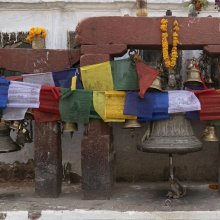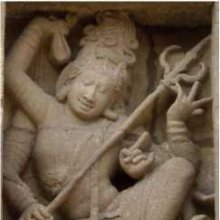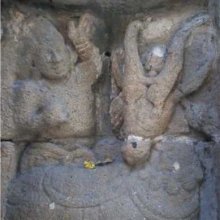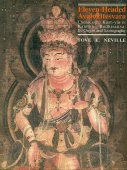Bell: 2 definitions
Introduction:
Bell means something in Hinduism, Sanskrit, the history of ancient India. If you want to know the exact meaning, history, etymology or English translation of this term then check out the descriptions on this page. Add your comment or reference to a book if you want to contribute to this summary article.
Images (photo gallery)
(+41 more images available)
In Hinduism
Natyashastra (theatrics and dramaturgy)
Source: Shodhganga: Elements of Art and Architecture in the Trtiyakhanda of the Visnudharmottarapurana (natya)1) Bells (i.e., round-shaped objects) are associated with Padmakośa-hasta: one of the twenty-two Single-hand Gestures (in Indian Dramas) (known as asaṃyuktahastas), according to the Viṣṇudharmottarapurāṇa, an ancient Sanskrit text which (being encyclopedic in nature) deals with a variety of cultural topics such as arts, architecture, music, grammar and astronomy.—The word padmakośa means the calyx of a lotus. [...] The uses of the padmakośa-hasta posture are not mentioned in the Viṣṇudharmottarapurāṇa. But according to the Abhinayadarpaṇa, this posture denotes some round shaped objects like breast of a woman, ball, round shaped cooking pot, egg and bell. The padmakośa posture is also used to show the blowing buds of flowers like marigold, lotus etc. Some kind of fruits like mango and wood apple are also portrayed with his hand posture.
2) Bells are also associated with Kāṅgūla-hasta: another one of the twenty-two Single-hand Gestures.—In kāṅgūlahasta, the middle finger is set between the forefinger and thumb while the ring finger is bent and the little finger is quite upward. According to the Viṣṇudharmottarapurāṇa, the kāṅgūla posture is used to denote fruits. In the Abhinayadarpaṇa, this posture is said to indicate things as fruits, bell, birds like cakora and cātaka, coconut etc.

Natyashastra (नाट्यशास्त्र, nāṭyaśāstra) refers to both the ancient Indian tradition (shastra) of performing arts, (natya—theatrics, drama, dance, music), as well as the name of a Sanskrit work dealing with these subjects. It also teaches the rules for composing Dramatic plays (nataka), construction and performance of Theater, and Poetic works (kavya).
India history and geography
Source: Singhi Jain Series: Ratnaprabha-suri’s Kuvalayamala-katha (history)Bells (attached to banners) commonly decorated the Vimānas (temple complex) of ancient India, as vividly depicted in the Kathās (narrative poems) such as Uddyotanasūri in his 8th-century Kuvalayamālā (a Prakrit Campū, similar to Kāvya poetry).—Page 92.24-31: A Devī-vimāna is described as being decorated with rubies, pearls-pendants and festoons, rows of bells attached to banners, rows of vaijayantī flags fixed on the top, lotus-medallions formed by the inset work of rubies, figures of the lotus-pond and thus giving appearance of Padma-vimāna. [...]

The history of India traces the identification of countries, villages, towns and other regions of India, as well as mythology, zoology, royal dynasties, rulers, tribes, local festivities and traditions and regional languages. Ancient India enjoyed religious freedom and encourages the path of Dharma, a concept common to Buddhism, Hinduism, and Jainism.
See also (Relevant definitions)
Starts with (+96): Bell agapanthus, Bell apple, Bell bauhinia, Bell fruit, Bell gardenia, Bell rue, Bell-metal, Bella, Bellaccari, Bellaco caspi, Bellada, Belladakil, Belladakilu, Belladi, Belladiya, Belladona, Belladonna, Belladonna lily, Bellagadda, Bellaganike.
Ends with (+9): Alpine bluebell, Amberbell, Australian bluebell, Blue bell, Bluebell, California bluebell, Dabell, Fourleaf ladybell, Gentian rock-bell, Harebell, Hedgebell, Hen bell, Littlebell, Marsh harebell, New zealand christmas bell, Pilose asia-bell, Scarlet bell, Scottish bluebell, Southern bluebell, Southern harebell.
Full-text (+967): Ghanta, Kinkini, Kamsya, Ghantika, Kshudraghantika, Ghantavant, Ghargharika, Ghantatada, Lohaja, Ghantin, Gharghari, Ghantu, Ghantakarna, Pakkagamte, Gharghararava, Gejjepilli, Padapasha, Katishrinkhala, Ghamtagopura, Ghantatadana.
Relevant text
Search found 187 books and stories containing Bell; (plurals include: Bells). You can also click to the full overview containing English textual excerpts. Below are direct links for the most relevant articles:
The Skanda Purana (by G. V. Tagare)
Chapter 6 - The Fruit of Offering Tulasī Twigs and Sandalpaste < [Section 5 - Mārgaśīrṣa-māhātmya]
Chapter 43 - Giving ear to Dvārakā’s greatness and eminence of basil wood < [Section 4 - Dvārakā-māhātmya]
Chapter 57 - Ghaṇṭeśvara (ghaṇṭa-īśvara-liṅga) < [Section 2 - Caturaśīti-liṅga-māhātmya]
Pallava period (Social and Cultural History) (by S. Krishnamurthy)
Ornamental Diagonal Band across the Body < [Chapter 4 - Material Culture of the People]
Solid instruments (Ghana) < [Chapter 4 - Material Culture of the People]
Ornaments For Animals < [Chapter 4 - Material Culture of the People]
Garga Samhita (English) (by Danavir Goswami)
Verse 4.14.27 < [Chapter 14 - The Story of the Jālandharīs]
Verse 1.2.44 < [Chapter 2 - Description of the Abode of Śrī Goloka]
Verse 2.10.3 < [Chapter 10 - Description of Śrī Kṛṣṇa’s Herding the Cows]
Heimskringla (by Snorri Sturlson)
Part 28 - Of King Olaf's Miracle < [Chapter VIII - Saga Of Magnus The Good]
Part 259 - Of King Olaf's Miracles < [Chapter VII - Saga Of Olaf Haraldson]
Part 89 - Baptism Of The Icelanders < [Chapter VI - King Olaf Trygvason's Saga]
Vakyapadiya of Bhartrihari (by K. A. Subramania Iyer)
Verse 1.104 < [Book 1 - Brahma-kāṇḍa (or Āgama-samuccaya)]
Verse 3.8.2 < [Book 3 - Pada-kāṇḍa (8): Kriyā-samuddeśa (On Action)]
Hitopadesha (English translation) (by Sir Edwin Arnold)
Chapter 5 - The Story of the Terrible Bell < [Book Two - The Parting of Friends]
Related products









